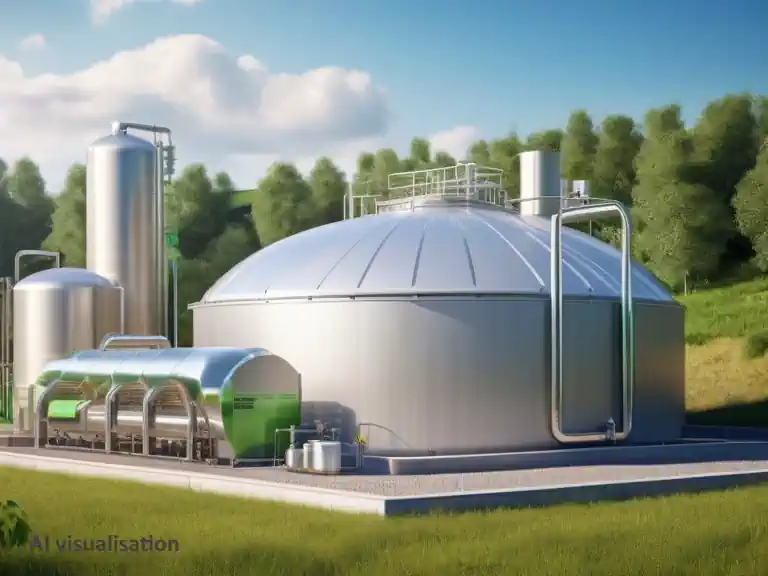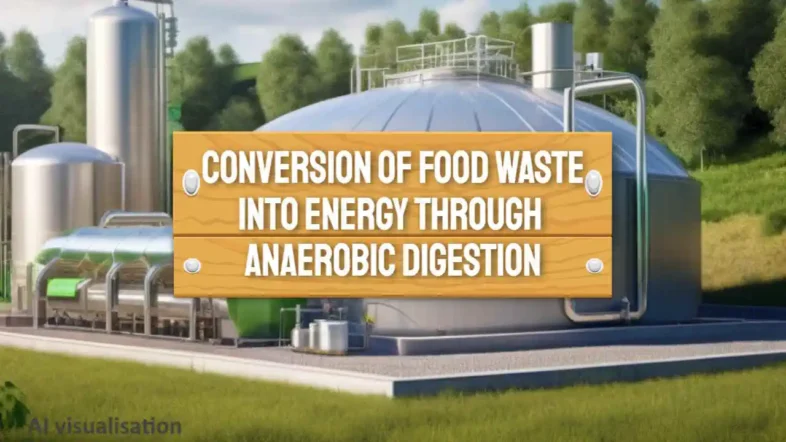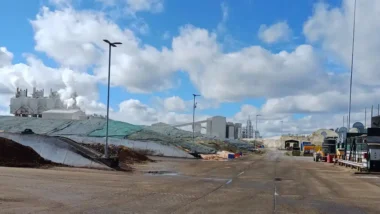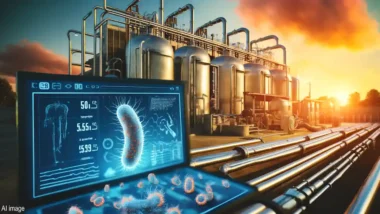Exploring The Conversion Of Food Waste Into Energy Through Anaerobic Digestion
Every year, heaps of food waste fill our bins and ultimately, our landfills. Anaerobic digestion is a clever method that transforms this waste into energy. This blog will guide you through how converting leftover food can light up homes and fuel cars.
Get ready to be inspired!
Food Waste Energy Key Takeaways
- Anaerobic digestion changes food waste into clean energy and biofertiliser, helping reduce landfill use and cut down greenhouse gas emissions.
- Using this process, 100 tons of food scraps can power hundreds of homes for a year, showcasing a practical way to create renewable energy.
- Countries like Germany, the United Kingdom, the United States, Sweden, and China are leading in using this technology to manage waste and produce energy.
- Start-ups are innovating in the renewable energy sector by transforming organic refuse into biogas for electricity and fuel for vehicles.
- This method supports a circular economy by recycling organic matter back into our systems as renewable natural gas or fertilisers for agriculture.
What is Anaerobic Digestion and How Does it Convert Stale Food into Energy?
Anaerobic digestion turns food waste into energy without using oxygen. This process happens in a special tank where tiny living things break down organic material, leading to the creation of biogas, which we can use for power and heat.
Conversion of food waste into energy through anaerobic digestion
Turning food waste into energy is smart and does a lot of good. It uses tiny life forms that don't need air to break down things we throw away, like leftovers from dinner or peels from fruits.
This process makes biogas, a type of gas that can heat our homes and even power cars. I've seen big tanks where all this magic happens. These tanks are called anaerobic digesters.
You put food waste in, and after some time, you get power out. Food waste energy is like giving trash a second life.
Food trash need not just sit around anymore; we turn it into something useful thanks to these digesters. Every day, heaps of wasted meals could light up hundreds of houses without using dirty climate-changing non-renewable fuels like coal or oil.
Moving on, let's explore the benefits such changes bring to our planet…

How the process works on a large scale
Anaerobic digestion turns food waste into energy. This natural process uses microorganisms tiny life forms to break down organic matter, not by composting in air, but by “digestion” in the absence of oxygen.
Here's the way to make it happen:
- Prepare food scraps for source-separated collection
Homes and businesses take care to place their food scraps and uneaten, out-of-date, food in separate bins or caddies. Waste management food waste collection contractors gather this food waste from homes, restaurants, and markets.
- Pre-treat the waste
They use machines like the Drycake Twister depackager and separator to remove non-organic parts including plastic bags, and oddments such as food containers in the source separated organic waste (SSO). This makes it easier for microorganisms to eat it up later.
- Move the prepared waste into a digester tank
The biogas plant anaerobic digestion tank is a big container that keeps oxygen out. Here, the magic starts as microorganisms begin their work.
- Microorganisms get busy
Different tiny life forms take turns breaking down the waste. The cell walls are broken open. First, bacteria turn complex compounds into simpler substances.
- Methane-producing life forms take over
That's the pre-digestion stage when hydrolysis takes place, meaning that the cell walls are broken and the next stage can start. After pre-digestion, healthy organisms in the liquid and solid mixture (substrate) known as methanogens, step in to produce biogas by eating up simple substances created earlier.
- Capture the biogas
This gas mixture (biogas), mainly methane, bubbles up and is collected from the top of the tank. It can now be used as fuel for producing electricity or heating buildings.
- Convert biogas to energy
Using generators (combustion engines coupled to rotating magnetic coils) and preferably combined heat and power systems, facilities burn biogas to generate electricity and provide warmth to nearby places.
- Use leftovers (the digestate) as biofertiliser
After taking all useful gas out, what remains in the tank is digestate – a nutrient-rich substance that farms and gardens can use to grow crops better.
Each step ensures nothing goes to waste—from turning leftovers into valuable energy sources to giving back to earth as fertiliser.
Through this cycle, we not only treat waste but also tap into a renewable source of energy that lessens our dependence on fossil fuels and reduces harmful emissions that cause climate change.

Pre-treatment of food waste
After learning how the process works, let's focus on achieving the initial critical step, the pre-treatment of food waste. This stage prepares the waste to ensure the anaerobic digestion process runs smoothly and efficiently. Here are the essential steps involved:
- Collection and transport – Collecting food waste from various sources is the first step. This includes leftovers from homes, restaurants, and grocery stores. Trucks then transport this waste to treatment facilities.
- Sorting – Workers or machines like the Twister Depackaging and Separation System sort the collected waste at the facility. They remove non-organic materials like plastics and metals that can't go into digesters.
- Pulping – The organic waste goes through a pulping stage that breaks it down into a slurry. Adding the right amount of water makes it easier for microorganisms to access the food during digestion.
- Homogenisation (optional) – This step mixes the pulped waste thoroughly, creating a uniform blend. It helps ensure consistent biogas production across different batches of waste.
- Removal of contaminants – Even after sorting, some non-organics slip through. A decontamination process may be added to remove these, preventing the build-up of inorganic material in the digester tanks.
- Adjusting pH levels – Specialists at the biogas plant test and adjust the pH of the slurry, ensuring an ideal environment for microorganisms that will break down the waste.
Inside the anaerobic digestion tank or vessel
Microbes start working on the organic waste as soon as it enters the anaerobic digestion tank (digester). They break down this matter and by doing that this process turns food scraps into biogas and biofertiliser.
The biogas is a mix of methane and carbon dioxide, useful for creating energy. The biofertiliser helps in farming by improving soil health.
The digestion chamber must stay sealed to keep oxygen out and very warm, or hot, to maintain the right conditions for microbes to work efficiently. Temperature control is crucial; too cold, and the microbes slow down; too warm, they might not survive.
This balance ensures that from every 100 tons of food waste, enough renewable energy is produced to power hundreds of homes each year.

Biogas production
This process creates a mix of methane and carbon dioxide–biogas.
From my own work in this field, I've seen how biogas can turn into electricity or heat for homes and businesses. It's like giving new life to what was once just thrown away.
Using this gas, we not only keep it out of the atmosphere but also use it to lessen our reliance on fossil fuels. Think about it: with 100 tons of food scraps every day, we could power up to 1,400 homes for a year! Biogas can even fuel cars and buses, after it has been purified to separate out the methane, making it a versatile energy source.
The purified biogas is called biomethane. When burnt it burns cleanly without the air pollutants from burning coal or oil based fuels.
Every step, from feeding in waste to producing energy, is a stride towards greener living and cleaner air for everyone.
The Benefits of Using Food Waste as a Source of Energy
Turning food waste into energy cuts down on what we throw away. It makes clean power too.

Reducing landfill waste
Reducing landfill waste keeps our planet cleaner. By turning food scraps into energy, we use anaerobic digestion to tackle this issue head-on. This method stops food from just sitting in rubbish dumps where it is digested in an uncontrolled manner producing harmful global warming methane gas half of which simply escapes into the air, even when collected as carefully as possible.
Instead, the process transforms these leftovers into biogas and biofertiliser, showing a smart way to manage our rubbish.
It's a win-win for everyone – making less waste and more energy at the same time.
Generating clean and renewable energy
Turning food waste into energy is a smart move. It's something we've seen working at many biogas plants.
Imagine taking leftovers and turning them into power for homes. That's what happens with anaerobic digestion—a process that takes organic rubbish and transforms it into biogas.
This gas can light up our houses or even fuel our cars, making it a great source of clean energy.
The beauty of this is clear. For every 100 tons of thrown-away food, we can power hundreds of homes for a year. Think about it—this means less waste in landfills and more renewable, green energy for us to use.
It’s like giving trash a second life as something valuable.

Contributing to a circular economy
Moving from generating clean energy, let's focus on how anaerobic digestion helps create a circular economy. This process turns food waste into renewable resources instead of letting it end up in landfills.
I've seen firsthand how businesses that adopt this technology not only cut down on their carbon emissions but also improve their sustainability score. They use every bit of waste as a resource, closing the loop in the production cycle.
Companies worldwide are seeing the value in this shift towards a more sustainable model. They use digestate, the by-product of anaerobic digestion, as biofertiliser to enrich soil for future crops.
This creates a win-win situation, reducing waste while supporting agriculture with organic fertilisers coming from what was once considered trash. It's clear that embracing anaerobic digestion is key to building economies that work within nature's limits and recycle what we can back into our systems.
The Global Movement Towards Anaerobic Digestion
Countries around the world are catching on to the power of turning food waste into energy. This movement is growing fast, with nations investing in technology like biodigesters to make it happen.

Countries already utilising this technology
Various countries have adopted this technology, showcasing its viability and benefits. Here's a glance at some nations leading the way:
| Country | Highlights |
|---|---|
| Germany | A frontrunner in biogas production, with thousands of plants converting organic waste into energy. |
| United Kingdom | Significant investments in anaerobic digestion facilities, aiming to reduce food waste and produce renewable energy. |
| United States | Increasing adoption of anaerobic digestion technology, with facilities across the country processing food waste for energy. |
| Sweden | Utilises biogas for heating and as a fuel for vehicles, showcasing a commitment to sustainable energy solutions. |
| China, with examples also in India, Africa, South America, South East Asia | Massive potential and rapid growth in anaerobic digestion capacity, supporting both waste management, the circular economy, and energy generation goals. |
The adopting nations exemplify the global shift towards sustainable waste management and renewable energy production. The applications and benefits of anaerobic digestion extend far beyond these examples, offering exciting possibilities for businesses and communities worldwide.

Potential for growth and impact
Countries around the world are starting to see the light. They're turning food scraps into power for homes and fuel for vehicles. This move towards anaerobic digestion has huge growth potential.
With every 100 tons of wasted food, we can light up hundreds of homes for a year. Imagine the impact of reducing harmful gases from landfills!
In my own experience working with start-ups in the renewable energy sector, I've seen firsthand how quickly this technology can take off. These companies are not just talking about change; they're making it happen by setting up plants that turn waste into electricity and gas for communities.
The interest is there, and so is the need – all that's left is scaling up these solutions worldwide.
Next, let's explore how businesses can use this green tech to their advantage.
Start-ups in the renewable energy sector
The shift towards greener energy solutions opens the door for innovative companies. Start-ups in the renewable energy sector are stepping up, transforming food waste into power.
- EcoEnergy Solutions – This firm focuses on turning leftovers from kitchens and restaurants into a valuable resource. They collect scraps, process them through anaerobic digestion, and convert them into biogas. This gas then powers homes and businesses, creating a loop that benefits everyone.
- GreenPower BioFuels – Specialising in biofuel production, GreenPower BioFuels advances the technology for converting organic waste into liquid fuel. Their unique approach helps vehicles run on cleaner energy produced from unwanted food items, reducing reliance on fossil fuels.
- WasteNot Energy – A pioneer in harnessing electricity from decomposing food, WasteNot Energy partners with local communities to set up digesters at landfills. These plants capture methane that would otherwise escape into the atmosphere and use it to generate electricity.
- AgriGas Ltd – Working primarily with farm waste, AgriGas Ltd creates sustainable farming solutions by producing biogas and biofertiliser through anaerobic digestion. Farmers can recycle their waste and gain both an energy source and a natural fertiliser, closing the loop on farm sustainability.
- CleanFlow Energy – CleanFlow Energy focuses on wastewater treatment plants as their source of food waste for energy recovery. By integrating anaerobic digestion systems into these facilities, they tap a continuous stream of organic matter to produce biogas, addressing water pollution and energy generation simultaneously.
- ZeroWaste Innovations Inc – This start-up envisions a zero-waste world where all food scraps are converted into energy or resources for other purposes like fertilisers or industrial chemicals through advanced conversion processes beyond traditional anaerobic digestion.
- BioGen Enterprises – BioGen Enterprises takes a broad approach by not only focusing on food waste but also exploring other organic materials such as crop residues for biogas production. Their technology adapts to different feedstocks offering flexible solutions for renewable biogas generation across various sectors.
These start-ups stand at the forefront of innovation within the renewable energy sector, showcasing how commitment paired with technology can address environmental challenges head-on while generating sustainable power sources.

Applications of Anaerobic Digestion for Businesses
Anaerobic digestion turns food waste into power for businesses—think lighting up office spaces or running machinery. This process doesn't just save money but also boosts a company's green image.
Imagine powering an entire building with what was once tossed in the bin! Explore how your business can join this green revolution.
Powering homes and communities
Turning food waste into energy offers a clean, renewable way to power our homes and communities. It is not something that can be dismissed as too small to matter. For example, by 2031 it is predicted that UK biogas production will be equal to the output of all UK nuclear energy produced.
This process uses anaerobic digestion—a method where tiny organisms break down this waste in the absence of oxygen—converting it directly into biogas. This gas can then be used as biofuel for vehicles or burnt to produce both heat and power.
The exciting part is that this isn't limited to households alone; entire neighbourhoods could see their carbon footprint shrink drastically. By integrating biogas systems into local energy plans, towns can tap into a continuous stream of green energy coming right from what would otherwise be landfill material.
Next comes exploring how businesses are getting involved with anaerobic digestion's many possibilities.
Use in wastewater treatment
After looking at how anaerobic digestion powers homes and communities, we see its role in cleaning water. Wastewater treatment plants use this process to break down sewage sludge and industrial waste.
This method turns harmful materials into clean water and energy. I visited a plant last year and saw huge tanks where microbes eat away at the waste. They release biogas as they work.
This gas is then used to generate electricity for the plant's own power needs, with plenty left over for powering nearby areas. Once again, the leftover material from the tanks might be used to help farmers as a fertiliser, closing the loop on waste use.
It's smart, eco-friendly, and shows how through converting food waste to energy our old waste can help grow new life.
Producing hydrogen and power-to-gas
Anaerobic digestion does more than just create biogas for electricity and heating. It opens the door to producing hydrogen and converting power-to-gas, offering alternatives for clean energy.
This process involves using the biogas from food waste to make hydrogen, a fuel of the future that will power cars and buses without pollution. For this power-to-gas system, engineers convert electrical energy into hydrogen gas.
This technology is paving the way towards a zero-waste society. Businesses can use these methods to cut down on methane emissions from landfill sites while supplying homes with sustainable fuels.
Hydrogen production also helps motor vehicles in running cleaner, reducing our carbon footprint even further. Through power-to-gas conversion, we store excess renewable energy efficiently, making sure nothing goes to waste in our journey toward greener living.
How Anaerobic Digestion Can Help Create a Sustainable Future
Anaerobic digestion turns food waste into clean energy, cutting down greenhouse gas emissions. This technology supports a circular economy by recycling organic matter and producing renewable natural gas.
Reducing greenhouse gas emissions
Converting food waste into energy through anaerobic digestion cuts down methane emissions from landfills. Methane is a potent greenhouse gas, much stronger than carbon dioxide over the short term.
This process transforms what would be harmful emissions into renewable energy, like electricity and heat for homes and businesses. Every 100 tons of food scraps processed can power hundreds of houses each year, making a significant impact on our fight against climate change.
Turning to this sustainable method also supports a circular economy where nothing goes to waste. It represents an innovative way to manage organic refuse while generating valuable resources.
By reducing reliance on fossil fuels and cutting down greenhouse gases, anaerobic digestion plays a crucial role in creating cleaner air for everyone.
Promoting a circular economy
Through anaerobic digestion, food waste transforms into energy, pushing us closer to a circular economy. This shift means less rubbish in landfills and more renewable resources circulating back into our communities.
Think of it like nature's own recycling system – but for our leftover food. Every bit of waste turned into energy reduces the need for fossil fuels and cuts down methane emissions from rotting rubbish dumps.
This approach not only powers homes and businesses but also fuels vehicles with biomethane instead of petrol or diesel. It's a win-win: cleaner air to breathe and a smaller carbon footprint.
Anaerobic digestion plants turn food waste to energy, from our kitchen scraps, into valuable biofuel, showing us that what we throw away can actually power the future. By embracing this technology, governments and industries can drive forward towards sustainability goals, making the planet healthier for everyone.
The role of technology and innovation in furthering this energy source
Technology and innovation play a crucial part in advancing anaerobic digestion as a key source of renewable energy. New advancements help make the process more efficient, allowing us to turn even more food waste into clean energy.
The latest depackaging technologies improve how we pre-treat and break down organic matter before it enters digestion tanks. This means we can produce biogas faster and use less space.
Innovative methods have been developed over the last 15 years to also enhance biogas purification, upgrading it into higher-quality fuel for various uses, from powering homes to running vehicles. Companies across the globe are continually developing cutting-edge solutions that transform wasted food into valuable resources with higher-quality pulp and lower emission outputs.
These steps forward not only support our environment but also pave the way for a sustainable energy future where nothing goes to waste.

Food Waste Energy Conclusion
Turning food waste into energy through anaerobic digestion is a smart move. This process uses tiny life forms to break down organic matter, creating biogas and biofertiliser. It keeps our planet cleaner by reducing what goes to landfills and cuts down on harmful gases from those places.
Imagine it! This technology is powering up many thousands of homes with just the leftovers from our meals!
Let's make this vision real by supporting renewable energy projects that use food scraps for power. It’s time we all played a part in creating a better future—one where waste becomes our next big energy source.
Food Waste Energy FAQs
1. What is the anaerobic digestion of food waste?
Anaerobic digestion, quite simply put, turns your leftover food into energy! It's a process where microorganisms break down biowaste in the absence of oxygen, creating renewable fuel like biogas. This magic happens mostly out of sight and helps us tackle global warming by reducing methane gas emissions.
2. How does converting food waste to energy help our planet?
Turning food waste into energy not only reduces the amount going to incinerators or landfills but also cuts down on harmful greenhouse gases. Plus, it creates bioenergy – that’s electricity and heat – from renewables instead of fossil fuels, making our energy sources cleaner and helping us inch closer to being carbon-neutral.
3. Can all types of food waste be used for energy recovery?
Yes, most types can! From your uneaten veg to the leftovers from dinner parties—all sorts of organic matter can feed into anaerobic digesters to produce biofuels contributing positively towards a lower carbon future. Even sewage sludge finds a noble use here!
4. What products come out of this process besides renewable fuel?
Besides the valuable biogas—which can power boilers or even vehicles—this clever process also produces digestate; think of it as super-composted material that enriches soil for crops without using chemical fertilisers. So really, it’s about getting everything we can from what we once thought was just rubbish.
5. Is this food waste energy technology accessible in developing countries?
Absolutely! With various scales available—from small community-led projects to larger industrial plants—anaerobic digestion offers flexible solutions across different settings including rural areas under programmes like the Rural Energy for America Programme (REAP). It provides an affordable path towards sustainable waste management and renewable fuel production everywhere.
6. How significant are cogeneration and biomass gasification in this context?
Cogeneration—or combined heat and power (CHP)—and biomass gasification are game-changers here; they magnify the benefits by ensuring nothing goes wasted during conversion processes: maximising output whether it's electricity, heat, or advanced biofuel while keeping emissions low—a win-win for both communities and our climate.





This biogas blog is a constant source of inspiration for me. Your passion for your subject matter is palpable, and it’s clear that you pour your heart and soul into every post. Keep up the work!